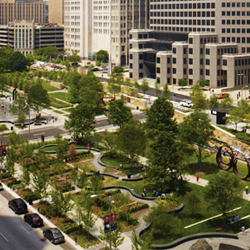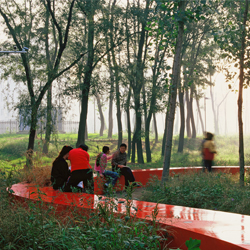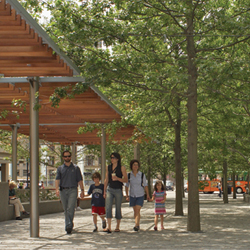Professional Practice
Green Infrastructure: Cities
Cities need as much green infrastructure as possible, given how dense and impermeable they tend to be. In the urban environment, green infrastructure covers everything from parks to street trees and green roofs to bioswales -- really anything that helps absorb, delay, and treat stormwater, mitigating flooding and pollution downstream. Green infrastructure also creates oxygen, sequesters carbon, and creates wildlife habitat. Urban greenery has also been proven to improve mental health and well-being.
Every city should have its own green infrastructure strategy and actionable plan to make it happen. Philadelphia and New York City are leading the way with model-breaking green infrastructure plans. In
Philadelphia, a comprehensive green infrastructure approach is
estimated to cost just $1.2 billion over the next 25 years, compared to
over $6 billion for "grey" infrastructure, a term used for the concrete tunnels created to move water. With this plan, 250 people are expected to be
employed annually in green jobs. The city is expecting up to 1.5 billion pounds of
carbon dioxide emission to be avoided or absorbed through green infrastructure
each year, the equivalent of removing close to 3,400 vehicles
from roadways. With improved air quality due to all the new trees, green roofs, and parks, communities will benefit on the social or health side, as well. The city estimates 20 deaths due to asthma will be avoided, and 250 fewer work or school days will be missed. Deaths due to excessive urban heat could also be cut by 250 over 20 years. Lastly, the economic benefits are also outstanding: the new greenery will increase property values by $390 million over 45 years, also boosting the property taxes the city takes in.
New York City’s green infrastructure plan
is projected to cost $1.5 billion less than a comparable grey
infrastructure approach. Green stormwater management systems alone will save $1 billion, at a cost of
about $0.15 less per gallon. Also, sustainability benefits in NYC range from
$139-418 million over the 20 year life of the project, depending on
measures implemented. The plan estimates that “every fully vegetated
acre of green infrastructure would provide total annual benefits of
$8.522 in reduced energy demand, $166 in reduced CO2 emissions, $1,044
in improved air quality, and $4,725 in increased property value.”
Spotlight on urban forests
Cities have forests, too, which are an important component of urban green infrastructure systems.* Smart urban policies are needed to increase the use of appropriate or native tree and plant species and reduce the presence of noxious and invasive ones. Using native plant communities contributes to place-making and identity; native vegetation also generally requires less maintenance and irrigation. In all cases, urban trees should be chosen for durability and resilience, character, growth habit, and aesthetic value. Urban forests should also include a diversity of species to avoid mono-cultures, which reduce biodiversity and are less resilient to pests and other environmental factors that can harm or kill trees. Plant and tree professionals, advocacy groups, and government agencies can facilitate sound plant selection and planting practices. Good design blends artistic and scientific best practices to create a healthy growing environment.
Recent federal legislation recognizes the many benefits of urban trees. The Energy Conservation Through Trees Act, authored
by Congresswoman Doris Matsui (CA) of Sacramento, would establish a
grant program with electricity providers to plant shade trees to
insulate residential buildings and minimize home heating and cooling
costs. The legislation would require an education and information
campaign to encourage residents to maintain their shade trees over a
long term; require monitoring and reporting of tree survival, growth,
overall health, and estimated savings; and require tree recipients to
provide stewardship and care of the trees.
*They are not, of course, the only component of urban green infrastructure. Be sure to see our sections on constructed wetlands, green streets, and green roofs & walls.
Additional benefits of urban forests include:
Energy Use
- Lower heating
and cooling energy costs: Lawrence Berkeley National Laboratory
and Sacramento Municipal Utility District found that trees placed around
houses to shade windows yielded between 7 and 47 percent energy savings.
Trees planted in the west and southwest of buildings yielded the highest
savings. Furthermore, a 20 percent tree canopy could result in
cooling savings of 8-18 percent and heating savings of 2 to 8
percent. (1)
- Urban trees resulted in energy savings of 11+ kWh/tree (yard) and
1.4+ kWh/tree (street) in a study quantifying ecosystem services resulting from
Portland, Oregon’s green infrastructure practices in 2009. (2)
Urban Heat Island
- Through their leaves, trees also provide evaporative cooling, which increases air humidity. Shaded surfaces may be 20-45 degrees cooler, and evapo-transpiration can reduce peak summer temperatures by 2-9 degrees. (3)
- Peak air temperatures in tree groves are 9
degrees cooler than open areas without trees. Furthermore, suburban areas with mature
trees are 4 to 6ºF (2 to 3ºC) cooler than new suburbs without trees. (1)
Water Management
- Evergreens and
conifers in Sacramento were found to intercept over 35 percent of the
rainfall that hit them. (1)
- Green
infrastructure approaches implemented in Chicago diverted over 70 million
gallons of stormwater in 2009 from the combined sewer overflow (CSO)
system. (4)
Air Pollution
- Urban trees reduced particulate matter less than 10 micrometers in diameter (PM-10) by 0.2 lbs per tree per year. Additional modeling found that 547 ha. of mixed greenspace within a 10 x 10 km square of East London could significantly reduce pollution with an estimated effect of two deaths and two hospital emissions avoided per year. (2,5)
- In urban areas with 100 pecent tree canopy cover, trees can reduce hourly ozone by up to 15 percent, sulfur dioxide by 14 percent, and particulate matter by 13 percent. (3)
- Modeling of removal of pollution by trees across the urban areas of the United States estimated that they remove 711,000 tonnes of pollution from the air per year with an economic value of $3.8 billion. This could be increased through increasing the density of tree cover. (3)
Carbon
- The net rate of carbon sequestered by urban
trees in the continental United States in 2005 is estimated to have been
around 24 million tons per year (88.5 million tons CO2), while current
total carbon storage in urban trees in the continental United States is approximately
700 million tons of carbon. (1)
- A single large healthy tree can remove greater than 300 pounds of carbon dioxide from the atmosphere every year. New York City’s urban forest alone removes 154,000 tons of CO2 annually. (3)
Property Values
- The value
of residential properties with the trees and vegetation are 3 to 10
percent higher than properties without. (1)
- Portland found
an approximate increase of $14,500 per tree for home value, including surrounding homes. (2)
- Philadelphia is
expecting an increase of up to $390 million in property values near parks
and green areas over the next 45 years. (6)
Sources:
1. "Reducing Urban Heat Islands: Compendium of Strategies: Trees and Vegetation,” U.S. Environmental Protection Agency
2."Portland’s Green Infrastructure: Quantifying the Health, Energy, and Community Livability Benefits,” Environmental
Services, City of Portland
3. “Sustaining America’s Trees and Forests,” U.S. Forest Service.
4. “Banking on Green: A Look at How Green Infrastructure Can Save Municipalities Money and Provide Economic Benefits Community-wide.” ASLA
5. “Microeconomic Evidence for the Benefits of Investment in the Environment – review.” Natural England
6. “Green City, Clean Waters: Green Infrastructure – The Philadelphia Story.” Philadelphia Parks & Recreation, The Dirt / ASLA
Organizations
Alliance for Community Trees
Arbor Day Foundation
Casey Trees
Human Dimensions of Urban Forestry and Urban Greening, College of Forest Resources, University of Washington
National Urban and Community Forestry Advisory Council
United Nations Environment Program
Urban Horticultural Institute, Cornell University
Yale University School of Forestry and Environmental Studies
Urban Tree Planting Programs
Green Miami (Increase tree cover to 30 percent by 2017)
Grow Greener Boston (100,000 new trees by 2020)
Leading to a Greener London (Two million trees by 2025)
Million Trees NYC (Part of PlaNYC)
Million Trees L.A. (Target is one million new trees)
Plant a Billion Trees The Nature Conservancy
Plant-It 2020
TreeBaltimore (Double tree cover from 20 percent to 40 percent within 30 years)
TreeLink
United Nations Environment Program (UNEP) One Billion Tree Campaign
Resources
"A New Way to Plant Urban Trees," The Dirt
"Green Infrastructure Goes Large in NYC," The Dirt
"The New Philadelphia Story Is About Green Infrastructure," The Dirt
Government Resources
Benefits of NYC's Urban Forest, MillionTreesNYC
Urban and Community Forestry, United States Forest Service
U.K. Forestry Commission
Reducing the Urban Heat Island Effect (City of Chicago Government)
Urban Heat Island Mitigation Strategies (U.S. Environmental Protection Agency)
Northeaster Area: Urban & Community Forestry Resources and Urban Forest Effects on Environmental Quality, US Forest
Service
New York City Department of Parks and Recreation
City of Toronto Parks, Forestry and Recreation
Department
Research
 ASLA 2011 Professional General Design Honor Award, Citygarden, St. Louis, Nelson Byrd Woltz Landscape Architects / Image credit: Nelson Byrd Woltz Landscape Architects
ASLA 2011 Professional General Design Honor Award, Citygarden, St. Louis, Nelson Byrd Woltz Landscape Architects / Image credit: Nelson Byrd Woltz Landscape Architects
"Stormwater to Street Trees: Engineering Urban Forests for Stormwater Management," U.S. Environmental Protection Agency, 2013
“A Report on the City of New York’s Existing and Possible Tree Canopy,” University of
Vermont's Spatial Analysis Laboratory, with support from the Northern Research
Station, National Urban and Community Forestry Advisory Council, and the City
of New York, 2012
“Edible Urban Forests: Producing edible landscapes in Seattle’s urban forest,” USDA Forest Service Northeast Research
Station, Institute for Culture and Ecology, Ursinus College, University of
Washington, 2012
"Chicago, IL- A Case Study of How Green Infrastructure is Helping Manage Urban Stormwater Challenges," National Resources Defense Council, 2012.
“Planting the Living City: Best Practices in Planning Green Infrastructure—Results From Major U.S. Cities,” Journal of the American Planning Association, 2011.
"Best Practices in Planning Green Infrastructure—Results From Major U.S.Cities," University of Oregon Sustainable Cities Initiative, Journal of the
American Planning Association, 2011.
“Report on Enhanced Framework (SUSTAIN) and Field Applications for Placement of BMPs in Urban Watersheds,” U.S. Environmental Protection Agency, 2011
"Shades of Green: Measuring the Ecology of Urban Green Space in the Context of Human Health and Well-Being," Nature and Culture, 2010
"Sustaining America's Urban Trees and Forests," U.S. Forest Service, 2010
“Reducing Urban Heat Islands: Compendium of Strategies.Trees and Vegetation,” U.S. Environmental Protection Agency
"Restoration ecology processes to advance natural landscape design," Steven N. Handel, Rutgers University
“More in Store: Research on City Trees and Retail,” Kathleen L. Wolf, International Society of Arboriculture, April 2009
“Strip Malls, City Trees, and Community Values,” Kathleen L. Wolf, Agriculture and Urban Forestry, January 2009
"Urban Heat Island Mitigation Strategies Can Improve New York City’s Environment: Research on the Impact of Mitigation Strategies," Sustainable South Bronx / Columbia University Earth Institute, October 2008
“City of Indianapolis, Indiana: Municipal Forest Resource Analysis,” Paula J. Peper, E. Gregory McPherson, James R. Simpson, Kelaine E. Vargas, and Qingfu Xiao, April 2008
“Los Angeles One Million Tree Canopy Cover Assessment Final Report,” Greg McPherson, Jim Simpson, Qingfu Xiao, and Chelsea Wu, March 2007
"Assessing Urban Forest Effects and Values: New York City's Urban Forest," U.S. Forest Service and Ufore, 2007
"Projected Urban Growth (2000-2050) and Its Estimated Impact on US Forest Resource," Journal of Forestry, 2005
"The Effects of Urban Trees on Air Quality," U.S. Forest Service, 2002
"Evaluating Street Tree Microclimates in New York," Urban Horticulture Institute, Department of Floriculture and Ornamental Horticulture, Cornell University
Role of the Landscape Architect
 ASLA 2007 General Design Honor Award. The Red Ribbon - Tanghe River Park, Qinhuangdao City, Hebei Province, China. Turenscape and Peking University Graduate School of Landscape Architecture / Image credit: Kongjian Yu
ASLA 2007 General Design Honor Award. The Red Ribbon - Tanghe River Park, Qinhuangdao City, Hebei Province, China. Turenscape and Peking University Graduate School of Landscape Architecture / Image credit: Kongjian Yu
Landscape architects plan, design, and build green infrastructure systems. With planners and arborists, they lay out broader urban forestry plans, using their skills to determine how thousands of trees can be added in an efficient and artful manner. Some also conduct research on how to best incorporate tree species into different urban environments. With planners and engineers, landscape architects design everything from urban parks and plazas to promenades and streetscapes, which all improve the social and ecological function of the urban environment.
Green infrastructure systems are complex: Urban vegetation must be chosen for durability and resilience, character, growth habit, and aesthetic value. Paving materials used in these systems must be permeable and also funnel water into bioswales or bioretention areas to treat and absorb stormwater. Landscape architects understand how to incorporate ecological functions into urban areas while also designing spaces for a diverse group of users and programs.
Projects
Adding Green to Urban Design, Chicago (City of Chicago)
Lafitte Greenway + Revitalization Corridor | Linking New Orleans Neighborhoods, New
Orleans (Design Workshop, Inc.)
 ASLA 2011 Professional General Design Honor Award, Contrasting Shade: Building a Sustainable Urban Grove at Central Wharf Plaza, Boston, Reed Hilderbrand / Image Credit: Charles Mayer Photography
ASLA 2011 Professional General Design Honor Award, Contrasting Shade: Building a Sustainable Urban Grove at Central Wharf Plaza, Boston, Reed Hilderbrand / Image Credit: Charles Mayer Photography
City/Park Hybridized, Laguna Beach, CA (SWA Group)
Sherbourne Common, Toronto (Phillips Farevaag Smallenberg)
Governors Island Park and Public Space Master Plan, New York City (West 8 Urban Design
& Landscape Architecture)
Contrasting Shade: Building a Sustainable Urban Grove at Central Wharf Plaza, Boston (Reed
Hilderbrand)
Citygarden,
St. Louis (Nelson Byrd Woltz Landscape Architects)
Integrating Stormwater Management and Public Amenities through a Public-Private Partnership, Canal Park – Washington, DC (OLIN)
Green Infrastructure Master Plan, City of Nashville
Trinity River Corridor Design Guidelines, Dallas, TX (Wallace Roberts & Todd)
The Floyds Fork Greenway Master Plan, Louisville, KY (Wallace Roberts & Todd, LLC)
Port Lands Estuary: Reinventing the Don River as an Agent of Urbanism, Toronto, Ontario, Canada (Michael Van Valkenburgh Associates, Inc.)
Seattle Green Factor, Seattle,Washington (City of Seattle Department of Planning and Development)
<< Wildlife Habitat & Corridors
Constructed Wetlands >>